On my second day of volunteering at the Norwich Cathedral egg hunt, I was signed up to work with Susanne, another volunteer. She turned out to be a lovely woman, and while we went around delivering Cadbury’s finest chocolate eggs, we chatted about an assortment of things. I learned that she has two daughters, both of whom studied abroad in the States while they were getting their degrees. It was nice to talk to a British “soccer/football mom”. Working with her made me realize that although I have gotten to meet British students and teachers, I haven’t interacted very much with adults outside of academia. There is an entire generation of people we are missing out on. I wonder if that would have been different had the program involved a home stay family.
On a different note, this day was very exciting because our supervisor, Juliet, took us on a tour of the upper level of the Cathedral. This section is not open to the public or even to most members of the church, so it was a great privilege to be invited. We got to walk right underneath the big stain glass windows, so close that I could touch it. We also walked right onto the organ.
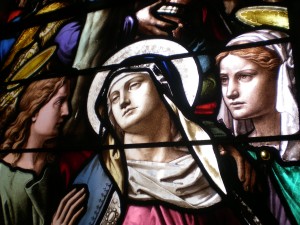
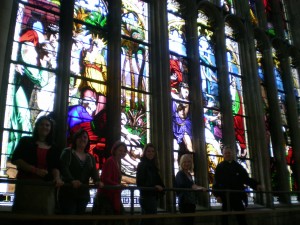
As we walked along each wall of the Cathedral, Stephenie and Juliet explained the significance of a lot of the architecture and some of the more intricate designs. There were carvings in the wall, most of them dated, and we made a game of trying to find the earliest ones. It’s rather mind boggling to think of all that history wrapped up in one building.
Date: 13/4
Supervisor: Juliet Corbett
Hours:10-3 (5)
Total Hours: 9
Tags: 2010 Sarah

Picture taken by Stephenie McGucken
A few weeks ago I received an email from Stephenie McGucken asking if I was interested in volunteering for the Norwich Cathedral’s Easter activities. I immediately replied YES. Who turns down an opportunity involving candy? Even though I myself am Jewish, a good portion of my family is Christian and we have an Easter egg hunt every year. I always had fun and I enjoy working with kids so I thought it would be a nice way to earn my volunteer hours. Although the experience turned out to be a little different than I expected, it was a positive one nonetheless.
We began by setting up the crafts table for the kids (and by we I mean Stephenie, Jess, Jamie and I). They were given Easter bunnies to color in and were able to build and decorate their own little paper Easter baskets for collecting eggs. My next job was to guide guests from the entrance of the Cathedral to story time which was the first activity station. This got a little tricky when the woman who was supposed to be working the station went missing for a few minutes. This meant that I had to be the fill in story teller.
As can be imagined, I felt more than a little uncomfortable reading a story about the resurrection of Jesus. It felt wrong to be telling a story which I don’t believe in. It seemed to me a lot like brainwashing. I realize that every religion, even my own, has its own collection of stories that it teaches to young children, but I still felt uncomfortable reading to the children. So I made the decision to politely decline to read should the situation come up again, and I moved on to the egg hunt.
Later on in the day, I mentioned to the priest that I had felt a bit awkward about being Jewish and volunteering to help with the Easter festivities. We had a really interesting discussion on the benefits of participating in other religion’s traditions. For while I had some difficulty reading the Easter book, it did help me to gain a better understanding of Christian beliefs. I know it sounds corny, but understanding really is the first step towards tolerance.
Date: 12/04/11
Time: 10-2
Hours: 4 Total: 4
Supervisor: Juliet Corbett
Tags: 2010 Sarah
September 22nd, 2010 · 1 Comment
As I and many others have mentioned in previous posts, examining religion and religious life in London has been a big part of our course. Central to increasing our knowledge and understanding of a number of religions has been visiting the various houses of worship. We have visited a few churches, a mosque, a mandir, and a synagogue. We have gone into these institutions with varying levels of welcome, and we have observed a variety of rituals, customs, and traditions.
Beauty has also been a recurring theme in the course. Almost all of the houses of worship that we visited had put serious thought and effort into the beautification of their buildings. The only exception was the mosque, but I think it is ok to assume that this was due to the financial circumstances of the community than lack of desire or appreciation for a beautiful space. In addition to all being beautiful, these spaces were all aesthetically very unique. The Mandir was extremely ornate, but not to the point of tackiness or fussiness. All of the stone and teak carvings were well executed and the building as a whole had a feel of luxury to it. The synagogue was a more simple, paired down building, but even as a more streamlined space, it still packed ample visual drama in the floor to ceiling red and gold mosaic behind the ark and tall, dramatic stained glass windows, which unfortunately had to be obscured by anti-terrorism curtains.
Comparing St. Paul’s and Westminster Abbey, aesthetically, St. Paul’s is the clear winner. Westminster Abbey is cluttered with tombs and plaques and statues, it is mostly dark and parts do look kind of shabby. Don’t get me wrong, it’s a place of great historical significance and cultural value, I’m not denying that, but on looks alone…. ehhh. St. Paul’s on the other hand, is light, airy, and spacious. It has a regal, elegant exterior and strikes a nice profile. The mosaics on the ceiling close to the WWII memorial were exceptional. As John explained to us, the tesserae had been set in at a specific angle, not flat against the wall, so that the sunlight reflects off of them just enough to allow them to glint and glitter. Perhaps over stepping here, but I think the visual atmosphere, the aesthetics of the particular houses of worship, reflect something of the character of the congregations who pray there.
Tags: 2010 Rachel · Uncategorized
September 21st, 2010 · No Comments
England’s religious identities are many. The influx of Muslims, Sikhs, and Hindus over the past century has turned the nation into a melting pot of both cultures and faiths. With the complexity of the social makeup of the city, it’s hard to pin down a “religious identity” for the whole of London. That being said, I think that one place of worship certainly has to be regarded as the national symbol for faith and strength- St. Paul’s Cathedral. While the religious denotations of the church are ever present, I don’t think the fact that it is a place of Christian worship is necessarily what gives it its majesty or its importance to Londoners across the metropolis. It is, above all, a symbol of a culture; strong and resilient, huge and complex, beautiful in its intricacies. There are two major times in London’s history during which the citizens of the city- Christian or not- have needed St. Paul’s.
Rebuilding after the Great Fire-
The Great Fire of 1666 ravaged the city whole. It gutted the mostly wood-lined streets and left a smoldering heap in its wake. The old St. Paul’s Cathedral (on whose ashes Wren’s St. Paul’s is built) was utterly destroyed. Wren sought to bring a new, majestic design to the table- he wanted a Renaissance-style dome to crown his masterwork and to be visible for miles around. While the design was initially scoffed at, his beautiful dome was completed and stood as the tallest structure in the city for three centuries. The cathedral is a symbol of Christianity, to be sure. But it is also, almost more importantly, a symbol of London’s rebirth from the depths of the catastrophe of 1666. The visible and towering symbol of Britain’s strength most certainly gave Londoners hope that their city was not only being restored, but taken to new heights.
The Blitz-
In terms of pure physical damage to the city, the only event that comes close to the devastation of the Great Fire is the Blitz. Nazi bombers annihilated much of the city in waves of attacks, night after night. Much of the history of the city was lost in the bombing raids, but the most important symbol of London’s strength miraculously remained. The iconic photograph of St. Paul’s, seemingly engulfed in flames but standing tall and true, is the embodiment of the church’s significance. Wren built the cathedral from the ashes of one fire with the intention that it would be a symbol of the strength of God and the strength of the city. The fact that the symbol itself resisted a second fire, an even greater test of resolve, is testament to its stature as the guiding light of London’s people. Christian or Muslim or Sikh, it’s impossible for Londoners not to stand in reverence (or, at least, in awe) of this building.

http://www.johndclare.net/wwii6b.htm
Tags: 2010 Patrick
September 21st, 2010 · No Comments
We have been to our fair share of churches, cathedrals, and other religious buidings. Looking up at the incredible painted ceilings and windows at these cathedrals, a visiting American would typically think, “My church doesn’t look like this”. The churches of London have been constructed by world famous architects for hundreds of years. The role of churches in London differs vastly from the purpose of churches in the United States (this we have discussed several times). The main purpose of these churches is rooted moreso in the Brits deep pride and value in their rich history a bit moreso than the prayers and sermons that are uttered in the buildings.

Westminster Abbey
Since my time spent here I have noticed that the Brits care a lot about, and ruthlessly display their long, inspiring history. I believe that these churches (St. Pauls, Westminster Abbey, etc.) serve as living pieces of history for the Brits moreso than places of worship for that reason. Walking through Westminster Abbey almost seems like your at some sort of Rock N’ Roll hall of fame for famous people’s graves. I can’t think of a better way of preserving and glorifying history than walking through a museum of dead guys with significant roles in the history of London. The elegant layouts and statues where the heroes of London stand frozen in time give places like the Abbey almost a museum-type feeling. I especially felt this way on our tours in the Abbey and St. James, where I felt like we were being ushered from exhibit to exhibit. The basement of St. Paul’s was even undergoing work so that they could put an exhibition on display, not unlike a museum.

St. Paul's Cathedral
Of course, these churches do still hold religious ceremonies; I saw a wedding at St. Pauls one of the days we went there, and there was a moment of silent prayer when we were touring Westminster Abbey. Our tour guides explained at several of the sites about how their regular services proceed as well. These religious observations still seem to be playing second fiddle to the awesome, breathtaking history that the churches hold. I am sure that more people attend tours than services on a daily basis at a place like St. Pauls or Westminster Abbey. Along with the Brits’ pride and dedication to their history, these churches serve as spots that honor the unification of London and its people as a whole. Hell, the entire country had a national religion in the Church of England for many, many years. One country, the majority of which were a member of one religion, and the church for which all these buildings were constructed. Our tour guide at St. Pauls explained how during the Blitz, a chaotic period that made the people of London fear for their lives on a day to day basis, that as long as they could see St. Paul’s church everything would be alright. Quite a deep belief on the part of the people of London. A belief reinforced by their nature of being proud of their past and their knowledge of it. So, while these churches and cathedrals might appear to be some kind of religious museum, they remain some of the most well recognized and inspiring aspects of London.
Photos courtesy of: members.virtualtourist.com, lilacnet.net
Tags: 2010 Benjamin
September 15th, 2010 · 7 Comments
Within the overarching theme of “Community” in our London course, we have talked almost ad nauseam about religion. Not only have we visited churches, a Hindu mandir, a mosque, and a synagog, but the topic of religion and its related issues come up daily in discussions amongst ourselves. (Completely unprovoked by Professor Qualls!) Several members of our group are particularly religious, and their world views and values reflect this. The strength of these individuals’ faith and beliefs fascinate me. It amazes me that people my age seem to have already got it all figured out, they know where they stand, when I haven’t even really begun to piece things together.
Religion has always been a topic of interest to me, because I have always struggled with it. There are just so many questions that can never really be answered in indisputable, concrete fact, not to mention so many faiths to choose from. Somehow, I always have a hard time… well, buying it. So for a long time now I have pushed religion to the back of my mind, I’ve tried to avoid the uneasiness and discomfort that comes with thinking about it. But now, in this environment, it is unavoidable. As a Jew (at least secularly) this is a particularly hard time of the year for me, as Rosh Hashanah has come and gone, unobserved by me, and Yom Kippur fast approaches. Since I have gone to college and it has been up to me whether or not I attend services for the high holidays, I so far have not. This does not mean, however, that I haven’t still felt pangs of guilt when I have watched the holidays come and go, no matter how hard I try to feign indifference. I feel deeply connected to my Judaism culturally, and I would consider it my ethnicity more so than generic “white,” but it feels decidedly half-hearted without the spiritual connection.
Since I’m already on the brink of pouring my heart out on a class blog, I may as well just tip the whole damn pot over. As some of you may have noticed, I became visibly upset during our visit to the synagogue the other day. I’m not sure what came over me, exactly. I was shocked that I reacted so strongly to something I’ve seen before. At every religious institution we have visited, we have seen very blatant physical manifestations of the subjugation of women. Although my synagog at home does not separate the men and women, and we have even had a woman rabbi, the fact that such discrimination (and for me, outright belittlement) occurs anywhere in the Jewish faith AT ALL deeply upsets me and creates an enormous obstacle for me to be able to come to full acceptance.
It’s not just the head coverings and other “modesty” clothing articles, even the separate seating I can almost tolerate, (separate is NOT equal, think back to the treatment of African Americans in the U.S. not long ago) but its the fact that women are denied leadership positions and the top level and most sacred aspects of the religion. (We have seen this in every religion we have looked at.) As Jews, we are taught that the Torah is the most sacred, wonderful thing we could ever experience. It is supposed to hold all of the information we need, all the rules by which to conduct ourselves, all the history of our earliest ancestors. In Orthodox Judaism, women are not allowed to read from the Torah, and they are not allowed to have a bat mitzvah, the rite of passage comparable to a bar mitzvah which marks a Jew’s transition from child to adult. (The rules vary from congregation to congregation, but I am speaking here of the most extreme, by the book, traditional interpretation.) If there really is a god as we are made to believe, I cannot accept that such a “perfect” being would condone sexism in any way, shape, or form. How is it at all logical, that something such as the Torah should be denied to half of the Jewish population? (as the orthodox see it).
Our guide at the synagog only increased my distress with his attempts to convey that Judaism is a matriarchal religion. It’s really not. Judaism is traced through the mother only because it’s always obvious who the mother of the child is, whereas the father was much dicier to verify before the age of paternity testing. At the synagog we visited, women are not allowed to read from the Torah. They may be bat mitzvahed, but it is a much shallower, lesser version. I tried to speak to our guide about this after he had given his long-winded, unbearable shpiel and he literally walked away from me. I have witnesses. It could have been that he just needed to catch up to lead the group, but instead of saying so and offering to discuss it further later, he simply ran away. I have tried to ask these questions numerous times, to many different people, and never, ever have I gotten a satisfying answer.
We have heard the argument that it is cultural rather than religious, but, looking at it pragmatically, culture should be adapted to contemporary times if there is no conflict with the scriptures. Why wouldn’t you move forward if nowhere does it say you can’t? Why do women put up with this? Open, institutionalized racism has been virtually wiped off the map, why hasn’t sexism?
People who believe that women cannot read from the Torah, or be rabbis, or become a priest, or the Pope, or an Imam, need to quit squirming around the issue and say outright the clear message they are sending: You are less.
Tags: 2010 Rachel
September 14th, 2010 · 4 Comments
The other day I went with a few others to the Newman House up the road from Arran House to attend Catholic mass. On the whole I think we all enjoyed the experience and actually gained a lot from it. For me, it was a relief to finally hear a native Englishman discuss the role of Catholicism in England, a topic I’ve been curious about even before coming to London.
Briefly looking around at the number of university students congregated in the small chapel, the priest quickly recognized that most were foreign to England. I could not tell whether or not his decision to touch on prominent hot button religious issues was planned. Regardless, the priest took advantage of preaching to the variety of students about contraceptives, abortion, homosexuality, and the global fear of Catholicism. Obviously they’re quite heavy, controversial issues to discuss in just a twenty-minute sermon.
Although the priest’s explanation of the Catholic Church’s view regarding homosexuality was particularly intriguing—and positive—, I was most interested in his discussion regarding the presence of Catholicism in England. He described the underlying sense of fear of Catholicism and the Papacy among the English. The priest made comments alluding to the English people’s standoffishness toward practicing Catholics and the Church on the whole. The discord among Anglicans and English Catholics apparent today may be incomparable to the country’s history but the unease among the English is still faintly visible. The priest at one point joked that the English fear the Papacy in Rome and devout Spanish Catholics will some day return to England to convert everyone back to Catholicism.
From my experience touring Westminster Abbey, St. Paul’s Cathedral, a Hindu mandir, Jewish synagogue, and Islamic mosque, and attending Catholic mass in a small university chapel, I have realized a subtle controversial religious dialogue materializing in London. England has an established church but their reaction to religious diversity is much different from America’s where no church is established. There is a fear of Catholics worldwide, but where I live the religion is thriving and accepted (again, that could easily be just because of my location in the northeast). I think religion is part of an American’s cultural identity but also one’s spiritual faith is more strongly expressed, whereas in England, Anglicanism easily becomes just a label. As Kate Fox described: a child once asked their parent what their religious background was, and the parent told the child to mark Anglican. When the child questioned this decision, the parent stated that that’s just what one was supposed to put. Furthermore, as the gentleman at the synagogue explained today, it would be unwise for a candidate for Prime Minister to publically share their religious beliefs, whereas in the United States, a politician’s religious devotion is widely broadcast. Although both nations continue to struggle with religious tolerance and freedom, I would say I feel more comfortable as Catholic in America than in England. I receive opposition in America, but I also feel free to defend my beliefs. Here in England, even people’s spiritual devotion to the established church is diminishing; completely ignoring the fact that Catholicism’s presence is seemingly minimal. Although my experience at the Newman House was most definitely positive, I look forward to finding a larger community of Catholic students at UEA in Norwich (hopefully).
Tags: 2010 Mary · Churches and Cathedrals
September 15th, 2009 · No Comments
As our time here in London comes to an end, I find myself needing to reflect on a few more aspects of London in my blogs. So this is my overview of London blog. It’s to touch upon the parts of London I either left out of previous blogs or the parts that I found to be my favorites. Also, I am hoping to cover assigned blog topics that I had not included in previous blogs.
To begin with I want to discuss the War Cabinet Rooms. I cannot believe I did not mention the War Cabinet Rooms in an earlier post. The presentation of the Cabinet Rooms was impeccable. I found myself very content to wander through the maze of the preserved Cabinet Rooms. Moreover, it guided the viewers through the rooms in such a way that it conveyed the detailed organization of the rooms and their role in World War II. I particularly enjoyed how there was emphasis placed on not only the role of the rooms in World War II London, but also how it was a representation of the determination of the British people. It provides a look into one of the most turbulent times in British and particularly London’s history. And it does not fail to reveal the main actors and issues of the time. For me, it achieved this through creating a museum based on the preserved and restored War Cabinet Rooms. The other museums of London were beneficial to walk through, but the only one where I felt there was respect not only behalf of the museum but on the behalf of the visitors was in the War Cabinet Rooms. Other museums I witnessed a horrifying lack of respect to the exhibits and artifacts. The worst incident o f disrespect happened in the British Museum. Visitors were touching the sculptures and taking vulgar tourist pictures with the mummies. It was embarrassing to witness.
Respect is something that I realize I find in the parts of London I liked the most. The theatre for instance inspires a great amount of respect, not only in the appearance of the actual theatres but through the performances. In all, excepting one, the performances we saw in London, I was inspired by the respect seen in the appearance of the theatres and in the sincerity of the actors’ performances. Each theatre I had the chance to enter was beautiful, even the Disney version of the Globe. All were inspiring to enter and be in for a performance. Luckily nearly all the performances I saw lived up to their settings, obviously I am excluding Blood Brothers from this. As I have said in earlier blogs, the respect the British have for theatre is remarkable. They have made it almost an innate part of their daily lives, at least here in London. This respect is something I have not had a chance to observe back home, at least not in such a widespread manner. Personally, the performance that was the best was Arcadia. It was a beautiful performance of an inspired script. And the Duke of York Theatre was a simple but beautiful setting for the performance. Also, I felt privileged to be in that audience, there was no instance of disrespect in the audience or even boredom. In comparison, Blood Brothers and its audience, myself included, was just awful. The musical was poorly performed and as such the audience was unable to settle in and enjoy. Fortunately though, one bad experience with London’s theatre did not put me off at all, instead it just makes me wish to ensure that the next performance I attend will be of better quality.
Another inspiring part of London are the churches. They are numerous and each uniquely beautiful. Initially, I had issues separating them in my mind; all were striking and imposing, especially St. Paul’s and Westminster. Over the weeks we have been here I have found myself differentiating between these churches and finding favorites. I must admit I have love for the grand architecture and history of the churches like Westminster Abbey and St. Paul’s Cathedral. It was an amazing opportunity to tour both of those churches and learn more of their histories. As I explored London on my own, I found that even the smallest churches here have long, intricate histories. I cannot say if I have a favorite church or even a preferred type of church in London. I guess I could answer more definitively if I had attended a service or two during our time here. Thus far though, I would say that my favorites have been ones where we have either toured or listened to concerts.
London as a whole has been a unique experience. It is one that ended too quickly now that I look back on it. Though, I look forward to the break from the city. This means I can return here in a few weeks or months and compare my experiences from now to the ones I will have in the future.
Tags: Kimberly
September 14th, 2009 · 2 Comments
I had the chance to attend the Feminist Literature tour in which I not only learned about women writers who resided in the Bloomsbury area, but also on how spaces affect who we are and everything that we do. I am intrigued with this notion. Recently I posted a blog on space, specifically focused on sacred/holy spaces, in this blog I will look back and focus on a few others others.
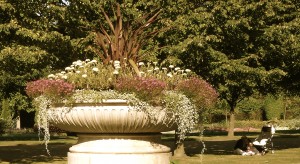
Green Green GREEN
Spaces of recreation, golden flowers and perfectly trimmed grass is what I think of. It is impressive to me how well kept they are. When we visited Regent’s Park during class for the first time, I was at a loss of words, for I had never in my life seen a space so beautiful. William Blake captures this beauty in his poem titled “The Lily:”
The modest Rose puts forth a thorn,
The humble sheep a threat’ning horn:
While the Lily white shall in love delight,
Nor a thorn nor a threat stain her beauty bright.
Regent’s Park could not be touched, human hands could never be gently enough to handle a flower’s delicate body. So untouchable, the flowers arranged almost to perfection. Ralph Waldo Emmerson once said that “Earth laughs in flowers,” and I believe him.
Hyde Park, almost as magical, but words cannot capture the immensity of this park. The amount of green that surrounds you at any given moment is difficult to describe. This park in particular serves as more than just a space for recreation, it is also a place where history is preserved, where various neighborhoods unite and where kids grow up to later bring their own kids to play at Kensington Gardens or near the lake. Green Park, a sort of gateway to Buckingham Palace (if you get off at the Green Park Tube station), can never be compared to Hyde Park for it lacks in immensity. Even though the deck chairs are a nice touch to the park, the area I visited lacked some color (as in floral color); I was not impressed. (Buckingham Palace itself was not very impressive. I was surprise to discover that it actually isn’t an enormous, glorious and royal-looking mansion… I guess it’s a good thing that it isn’t after all!)
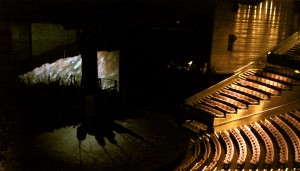
Let’s start the show!!!
Sometimes walking in for the first time takes my breath away, and sometimes the shows blows my mind, other times the idea of sitting there makes me wonder… wow. The three different halls of at the National Theatre, The Globe, Duke of York’s, the Phoenix and last but not least Royal Albert Hall! So here’s the list: “Troilus and Cressida,” “Arcadia,” “All’s Well That Ends Well,” “As You Like It,” “Pitmen Painters” and the not-so awesome musical “Blood Brothers,” oh and the amazing violin concerto at the Royal Albert. In London, I am never too far from New York City’s Broadway experience! The difference, the London experience always feels fulfilling no matter how horrible the play was. This is probably because Broadway shows are not exactly affordable, and while the National Theatre insists on having a wide range of prices (so that everyone can enjoy the theatre), Broadway just seeks revenue and to maintain it’s current status and popularity. I mean, to have Rick Fisher (who by the way is a Dickinson alum), winner of of a Tonny award, come to speak to us about his thoughts and experiences with London’s theatre scene, that within itself was enough to top all of the Broadway shows I have seen in my life! I <3 the London theatre experience!
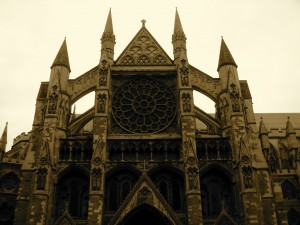
Religious spaces.
Intricate architecture, imagination, creativity and grace is what comes to mind when I think of churches. I’ve written a blog about them but I wanted to look back at a few of them. Westminster, ridiculously sacred, marvelous, immense and glorious. The same can be said about St. Paul’s Cathedral and the Hindu Temple we visited. At Brixton (where I directed a tour along with my teammates), I learned that religious spaces play a huge role in the community, one that extends beyond any religious affiliations. One specific church we visited during our research, Corpus Christi Roman Catholic church was involved in the reconstruction of the Brixton area after the Brixton riots, when parts of the neighborhood where damaged/destroyed due to violent protests. It always brings joy to my heart when people come together to help each other, regardless of any religious/cultural boundaries.

Clubs NOT Pubs
Ooooh pubs…. I’ve heard that you can see London’s history evolve in these spaces, and although they are known as spaces of leisure and social interaction their walls can tell unknown stories of both know and unknown visitors. I am always intrigued by pubs, so intrigued I am intimidated by them. I now that sounds a little ridiculous but in pubs I feel pressured to consume alcohol (after all that is the main purpose of a pub: to provide alcoholic beverages) and to maintain conversation when really all I want to do is dance to the awesome music playing in the background. Rebbeca (who along with 4 others constructed a tour of London’s historic pubs) has attempted to both enlighten me as well as persuade me to engage in pub culture, but I have yet to fully explore the wonderful world of London’s historic pubs.
Clubs, on the other hand, I’ve also had a difficult time with. I’ve realized that there isn’t much dancing that goes on, but rather an attempt to dance, which actually means jumping around to Lady Gaga’s “Just Dance” (pop/techno song). Over all, I have enjoyed late hip hop nights at Metra (dance club a few street corners off the Leichester Square tube stop) only because I have shared that space with amazing people who can turn any floor into a dance floor. (Thanks Anthony, Jeyla and Patsy!)
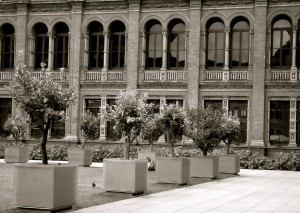
Spaces, our everyday living takes place within them, whether they are churches, clubs, parks or theaters. We lack to realize their importance, we never stop to think of how a room may affect how we feel about ourselves and about the rest of society. A room can change our lives, like the reading room at the British Museum that the feminist writers group spoke of on their tour. This room clearly changed Virginia’s Wolf literature, among other authors, I’m sure.
Note to self: Whether this room is physical or mental, it is important. We must take more time to appreciate a rooms ability to change the way we exist in our own individual worlds.
The End.
Tags: Flow · Uncategorized
September 7th, 2009 · 2 Comments
During our time in London, we have noticed that many of the religious institutions we have been visiting rely on gift shops and cafés to increase revenue. Some basic internet research shows that many people have mixed feelings about whether or not this practice is acceptable. Generally speaking, we do not believe it is necesarily inappropriate for a church or temple to sell refreshments or gifts related to the location or religion. Given a decrease in European religious sentiment and worldwide economic difficulty, donations aren’t a very reliable source of funding. If a place is to be kept open to a public (tourists and worshipers alike) it needs money to run. Employees and utilities need to be paid and maintenance isn’t cheap. It’s easy to understand the rationale behind the decision to open a shop.
For the most part, the places of worship we have visited had signs informing the guest that the proceeds from the shop or café benefit either local charity or the building itself. For example, St. Martin’s in the Fields’ gift shop benefits “the work” of the church. Additionally, the products sold are related to Christianity, the church itself, and the church’s location. Furthermore, the Shri Swaminarayan Mandir‘s gift shop sold incense, prayer beads, and other products Hindus would need for everyday use in addition to more “touristy” items. We consider all odthese items to be appropraite for such a shop; they are directly related to the place and its purpose.
Whilst visiting the Christ Church College in Oxford (this may or may not have been related to Harry Potter), we stumbled into “The Cathedral Shop” adjacent to the college’s chapel. Most of the items sold by this shop were very similar to the other gifts shops we previously encountered. There were chalices, books, t-shirts, postcards, etc. There was a fairly modest Harry Potter section relating the the films that were partially created at the location alongside a small section dedicated to Lewis Carroll’s Alice in Wonderland, which was written in Oxford.
However, we did notice a few items that did not seem appropriate for a shop entitled “The Cathedral Shop.” Instead, they seemed to be trying VERY hard to appeal to young, hip buyers:
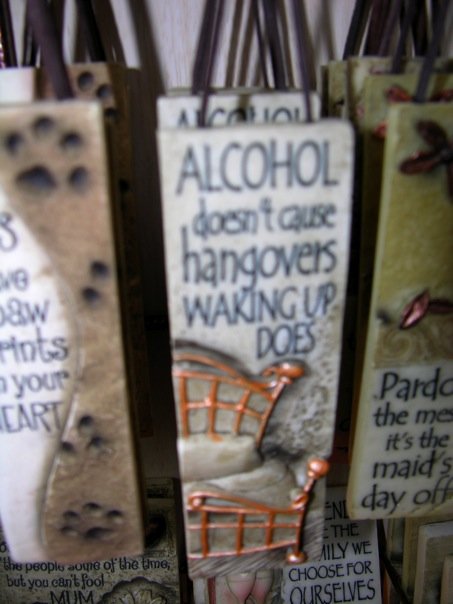
The last time we checked, no religion condones binge drinking and sleeping until 4pm and Oxford isn’t particularly famous for its hangovers.
We’re curious to see what everyone else in the group thinks about the idea of gift shops in religious buildings and what kinds of items they should sell.
Tags: Alli · Churches and Cathedrals · Sarah












